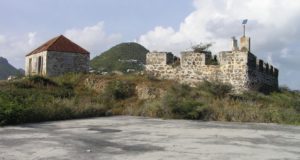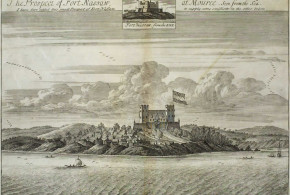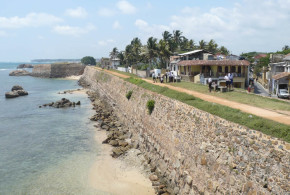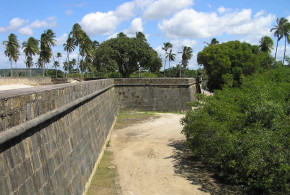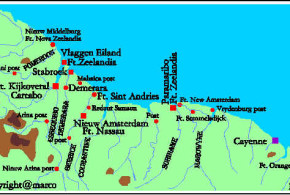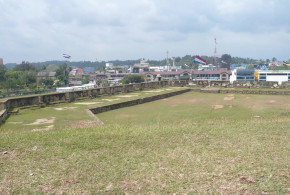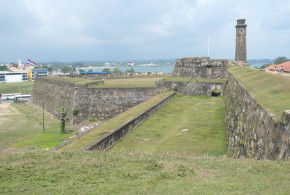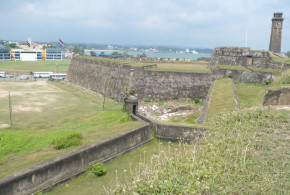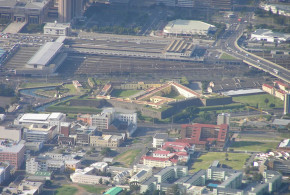Written by Marco Ramerini
BANGLA DESH:
Dhecca, Decca (Dhaka):
Netherlands: trading office Until 1704
Dhaka was the seat of the Nawab of Bengal. From 1664 the Nawab functioned as the viceroy of Bengal. He sent an emissary to the administration of the Company in Batavia requesting aid in his battle against the Arakan. Both the Dutch and the English established a presence in Dhaka because the town constituted the centre of the textile district. The settlement comprised several wattle houses with mud roots. According to the traveller and writer Tavernier, who visited the area around 1665, Decca boasted an attractive house that was built by the Dutch and which was used for storing goods.
Source: “Landmonsterrollen, 1691-1790” “Atlas of Mutual Heritage” www.nationaalarchief.nl
MYANMAR (BURMA):
Baungdwet, Baung Dwet (Bandel) Arakan (Mrauk-U):
Netherlands: trading office ca.1608-1631 1634- ?
Located 5 km south from the present town of Mrauk-U. The ruines of the Dutch trading center are still visible.
Source: Guedes “Interferencia e integraçaodos Portugueses na Birmania 1580-1630” p. 183
Siriam, Siriangh (Syriam):
Netherlands: trading office 1635-1679
Siriam was easy to access by water, the VOC founded an office in 1635. In 1679 the Company decided to close the office in Siriam.
Sources: Guedes “Interferencia e integraçaodos Portugueses na Birmania 1580-1630” p. 183
Dam, Pieter van “Beschryvinge van de Oostindische Compagnie (uitg. door Dr. F.W. Stapel)” 2e boek, dl.2, p. 86
“Atlas of Mutual Heritage” www.nationaalarchief.nl
Awa (Ava):
Netherlands: trading office ca. 1635-1679
Around 1635 the VOC established an office in Ava, which lay near the city of Mandalay. Here the Company traded in indigo, saltpetre, mercury and vermilion. In 1679 the Company decided to close down the post.
Source: Dam, Pieter van “Beschryvinge van de Oostindische Compagnie (uitg. door Dr. F.W. Stapel)” 2e boek, dl.2, p. 81
“Atlas of Mutual Heritage” www.nationaalarchief.nl
Arakan (Mandalay):
Netherlands: trading office 1625-1665
Source: Dam, Pieter van “Beschryvinge van de Oostindische Compagnie (uitg. door Dr. F.W. Stapel)” 2e boek, dl.2, p. 99
“Atlas of Mutual Heritage” www.nationaalarchief.nl
Martavaan (Martaban):
Netherlands: trading office ca. 1660- ?
According to Pieter van Dam, the VOC maintained a ‘comptoir’ in Martavaan around 1660. However this trading post on the West Coast of Birma was soon abandoned due to a ban imposed by the local ruler.
Source: Dam, Pieter van “Beschryvinge van de Oostindische Compagnie (uitg. door Dr. F.W. Stapel)” 2e boek, dl.2, p. 86
“Atlas of Mutual Heritage” www.nationaalarchief.nl
Pegu:
Netherlands: trading office
During the VOC period Pegu was a kingdom in the south of Burma. Here the VOC maintained a comptoir, which was however abandoned relatively quickly. The local traders flocked to Siriam, a little further south, where the VOC subsequently opened a post.
Source: Dam, Pieter van “Beschryvinge van de Oostindische Compagnie (uitg. door Dr. F.W. Stapel)” 2e boek, dl.2, p. 86
“Atlas of Mutual Heritage” www.nationaalarchief.nl
THAILAND:
Judia (Ayutthaya):
Netherlands:
Pakhuis Amsterdam Bangkok (Bangkok):
Netherlands:
Ligoor (Nakon Si Thammarat):
Netherlands:
Pattanij, Patani (Pattani):
Netherlands:
Oedjang Salang (Phuket):
Netherlands:
Singora (Songkhla):
Netherlands:
MALAYSIA:
Malacca (Melaka):
Netherlands:
Boucquetchina, Boucquet China, Bukit China, Boegit China (a Dutch outpost, little to the north-east of the city of Melaka)
Queda (Kuala Kedah):
Koela Linggi (Kuala Linggi): Fort Philippina
Salangoor (Kuala Selangor):
Fort Altingburg
Fort Utrecht
Perak (Tanjung Putus, on the mouth of the Perak River): In 1655 the VOC established a trading post in Perak.
Ilha das Naus: Shortly afterwards the conquest of Malacca, the Dutch, completed the
Portuguese fort on the Ilha das Naus (called by them Red Island).(according to “Melaka fort”.)
Dindings, Pangkor Eiland:
Dutch fort in Pangkor, Perak.
(Kota Belanda) Dutch Fort
The origins of the fort can be traced back to 1670, with the coming of the Dutch. It is located in the village of Teluk Gedung , a fishing village in Pangkor island. At this time, the Dutch had a monopoly on the export of tin in Perak. An earlier fort was built in 1651 but was destroyed. In 1670, Batavia ordered the construction of a wooden fort, ten years later it was replaced by a brick one. In 1690, the Malays under the leadership of Panglima Kulup, attacked, destroyed and killed several Dutchmen. The settlement was temporarily abandoned until 1743, when the Dutch returned and repaired it. The Dutch stationed 60 soldiers , inclusive of 30 Europeans.
In 1748, the Dutch built another fort near the Perak river. Following this the Dutch administrators ordered to abandon this fort. Originally the fort was used as a store for tin ,and now it is called ” Kota Belanda”. In 1973, the Museums Department rebuilt the fort but without a roof as they did not know the original plans. The fort measures 3.5 sq meters and 6.7 meters high.
CAMBODIA:
Ponomping (Phnom Penh):
Source: “Atlas of Mutual Heritage” www.nationaalarchief.nl
Laauweck (Lawec)
Netherlands: trading office 1620-1622; ?-?; ?-?; ?-1667
The town of Lawec in Cambodia was situated halfway along the Mekong River on the way to Phnom Penh. The VOC set up a trading post at Lauweck in 1620, but the trade there proved disappointing, and just two years later the company shut the post down. The Lawec trading post was reopened on three further occasions, but in 1667 the VOC left Cambodia for good. Besides deer hides and ray skins, Cambodia functioned mainly as a source of provisions for Batavia such as rice, butter, salted pork, and lard.
In 1644 a VOC delegation sailed up the river to Phnom Penh. Meanwhile a fortified dam with 50 guns was built behind them. The Company suffered heavy losses in the ensuing battle but nevertheless resumed relations with Cambodia some ten years later.
Source:
Dam, Pieter van, Beschryvinge van de Oostindische Compagnie (uitg. door Dr. F.W. Stapel), 2e boek, dl.1, p. 349
“Atlas of Mutual Heritage” www.nationaalarchief.nl
VIETNAM:
Ke-cho (Hanoi):
Netherlands: trading office 1636-1699
Towards the end of the 1630s, the Company signed an agreement with the king of Tonkin and opened a trading post in or near today’s Hanoi. The country was a major silk producer. The silk which the VOC bought there was particularly valuable for trade with Japan. The VOC maintained a trading post in Tonkin from 1636 to 1699. This trading post was run by an ‘opperhoofd’ or supervisor.
Source:
Boxer, Ch. R. “Francisco Vieira de Figueiredo”
“Landmonsterrollen, 1691-1790”
“Atlas of Mutual Heritage” www.nationaalarchief.nl
Faifo, Pheypho (Hoi An):
Source:
“Atlas of Mutual Heritage” www.nationaalarchief.nl
CHINA:
Hockzieuw, Hoksieu (Fuzhou):
Netherlands: trading office ? – 1681
After the loss of Taiwan in 1662, the VOC tried to acced to the Chinese porcelain and silk trade at the port of Fuzhou. However, the Company’s attempts to trade there were hampered by a string of bureaucratic restrictions. Although the trading post at Fuzhou barely made a profit, the VOC kept it on until 1681.
Source:
Dam, Pieter van, Beschryvinge van de Oostindische Compagnie (uitg. door Dr. F.W. Stapel), 2e boek, dl.1, p. 751
“Atlas of Mutual Heritage” www.nationaalarchief.nl
Whampoa (Huangpu):
Netherlands: warehouse ca. 1728- ?
Whampoa, an island situated in the Zhujiang river, served as the harbour of Canton. A Dutch warehouse was built here.
Source:
Muller, H.P.N., ‘Azië gespiegeld. Malakka en China’, Leiden 1918, p. 120
“Atlas of Mutual Heritage” www.nationaalarchief.nl
Kwantoeng, Canton (Guangzhou, Kanton):
Netherlands: trading office 1749-1803
Tea and porcelain were the principal products purchased by the VOC in Canton. In the 18th century the VOC rented permanent premises in Canton, next to the building occupied by the British.
Source:
Muller, H.P.N. “Azië gespiegeld. Malakka en China”Leiden, 1918 p. 122
“Atlas of Mutual Heritage” www.nationaalarchief.nl
FORMOSA-TAIWAN:
Tayoan, Zeelandia (An Ping): Fort Zeelandia 1624-1662
Kelang, Quelang (Chi-Lung):
Tamsuy, Tamsui (Tan-Shui):
Pehoe, Pescadores (Peng-Hu):
Netherlands: fortress with four bastions July/August 1622-August 1624
A fortress was built in Pehoe island in July/August 1622, by captain Cornelis Reyerszoon, it was with four corners in wich twenty guns were to be placed. Cornelis Reyerszoon remain in the fortress as commander until 1624. In August 1624, the Dutch left this place because the Chinese government reclamed it, the Pescadores belonged to the king of China. The Chinese suggested to the VOC to use Formosa as base for trade with China. The Dutch agreed and settled in a port called Taiuam (Tayoan). The fortress in Pehoe was destroyed.
A source inform us that Rev. Joannes Lutgens died around October 1651 (he was arrived in Formosa on 26 July 1651) in his station on the Pescadores islands.
Source:
“Relación de Salvador Diaz sobre la fortaleza holandesa de Taiuan, y de las actividades de los holandeses, japoneses y chincheos, Macao 26 de abril de 1626” published in Borao Mateo, J. E. “Spaniards in Taiwan, Vol. I 1582-1641” Taipei, 2001 pp. 62-63
Campbell, W. M. “Formosa under the Dutch” Taipei, 1972 pp. 27-35, 271
Saccam: Fort Provintia, Fort de Provintieën
Source:
Dam, Pieter van “Beschryvinge van de Oostindische Compagnie (uitg. door Dr. F.W. Stapel)” 2e boek, dl.1, p. 718
“Atlas of Mutual Heritage” www.nationaalarchief.nl
Wancan: a barricade ca. 1644
JAPAN:
Desima, Deshima, Decima (Nagasaki):
Netherlands: trading office 1641-1800
During the course of the 17th century Japan cut all its contacts with the rest of the world. The VOC, which had been based on the island of Hirado until 1641, was forced to move to the small island of Deshima in the bay of Nagasaki. After 1641 an ‘opperhoofd’ or supervisor was based at Deshima in charge of VOC trade with Japan. The trade with Japan was especially important in the 17th century, when the VOC purchased large quantities of silver, gold and copper there in exchange for deer hides from Formosa, Chinese silk, and spices from the Indonesian archipelago. Deshima was a small artificial island whose northern shore was linked to the town of Nagasaki by a stone bridge. In the 17th century the trading post in Deshima was the largest supplier of precious metals in Asia. Well into the 19th century, the Company’s employees were the only foreigners permitted to set foot on Japanese soil.
Source:
“Landmonsterrollen, 1691-1790”
“Atlas of Mutual Heritage” www.nationaalarchief.nl
Firando (Hirado):
Netherlands: trading office 1609-1641
In 1609 the VOC was permitted to set up a base on the small Japanese island of Hirado. Because the Shoguns were keenly interested in Dutch cannon, an iron foundry was built on Firando. From 1609 to 1641 Hirando served as an important port and storage depot for trade in Chinese territorial waters. The main trading product was Chinese silk, which was exchanged for precious metals in Japan. In 1641 the VOC was required to move its base to the small island of Deshima in the bay of Nagasaki, the office of Hirado was closed.
Source:
Dam, Pieter van “Beschryvinge van de Oostindische Compagnie (uitg. door Dr. F.W. Stapel),” 2e boek, dl.1, p. 366
“Atlas of Mutual Heritage” www.nationaalarchief.nl
 Colonial Voyage The website dedicated to the Colonial History
Colonial Voyage The website dedicated to the Colonial History





